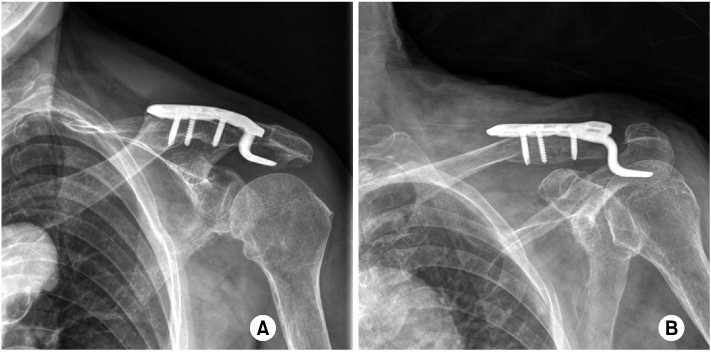J Korean Fract Soc.
2011 Oct;24(4):335-340.
Results of Hook Plate Fixation of Unstable Distal Clavicle Fractures
- Affiliations
-
- 1Department of Orthopaedic Surgery, National Medical Center, Seoul, Korea. shshs8383@naver.com
Abstract
- PURPOSE
This study evaluated the clinical and radiological outcomes of unstable distal clavicular fractures treated with an AO Hook plate.
MATERIALS AND METHODS
From March 2009 to October 2010, sixteen patients with distal clavicular fractures underwent open plating using an AO Hook plate. The clinical outcomes were assessed by measuring the UCLA scores and KSS sores, and the radiological outcomes were evaluated using simple radiographs at the final follow-up.
RESULTS
Fracture union was obtained in all patients at an average of 13.9 weeks (range, 9~20 weeks). The UCLA scoring system showed excellent results in 9 cases and good results in 7. The average KSS scores of distal clavicular fractures were 95.5. At the final follow-up, subacromial osteolysis developed in 11 cases (68.7%) of whom 3 suffered from pain around the acromion. Other complications occurred in 4 patients: one had a fracture adjacent to the plate proximally, two had a stiff shoulder with subacromial impingement, and one had hypoesthesia around the surgical wound.
CONCLUSION
Unstable distal clavicular fractures treated with a Hook plate provided rigid fixation and satisfactory outcomes considering the high union rate. Nevertheless, potential postoperative complications related to morphometric properties of the plate should be considered.
MeSH Terms
Figure
Reference
-
1. Banas MP, Miller RJ, Totterman S. Relationship between the lateral acromion angle and rotator cuff disease. J Shoulder Elbow Surg. 1995. 4:454–461.
Article2. Basamania CJ, Rockwood CA. Rockwood CA, editor. Fractures of the clavicle. The shoulder. 2008. 4th ed. Philadelphia: WB Saunders;428–482.
Article3. Chaudry SN, Waseem M. Clavicular hook plate: complications of retaining the implant. Injury. 2006. 37:665.
Article4. Chiang CL, Yang SW, Tsai MY, Kuen-Huang Chen C. Acromion osteolysis and fracture after hook plate fixation for acromioclavicular joint dislocation: a case report. J Shoulder Elbow Surg. 2010. 19:e13–e15.
Article5. ElMaraghy AW, Devereaux MW, Ravichandiran K, Agur AM. Subacromial morphometric assessment of the clavicle hook plate. Injury. 2010. 41:613–619.
Article6. Flinkkilä T, Ristiniemi J, Lakovaara M, Hyvönen P, Leppilahti J. Hook-plate fixation of unstable lateral clavicle fractures: a report on 63 patients. Acta Orthop. 2006. 77:644–649.
Article7. Hackenbruch W, Regazzoni P, Schwyzer K. Surgical treatment of lateral clavicular fracture with the "clavicular hooked plate". Z Unfallchir Versicherungsmed. 1994. 87:145–152.8. Hessmann M, Kirchner R, Baumgaertel F, Gehling H, Gotzen L. Treatment of unstable distal clavicular fractures with and without lesions of the acromioclavicular joint. Injury. 1996. 27:47–52.
Article9. Kang HJ, Park KK, Yoon HK, Song HK, Hahn SB. T plate fixation for unstable fracture of distal clavicle. J Korean Fract Soc. 2006. 19:329–334.
Article10. Kao FC, Chao EK, Chen CH, Yu SW, Chen CY, Yen CY. Treatment of distal clavicle fracture using Kirschner wires and tension-band wires. J Trauma. 2001. 51:522–525.
Article11. Kashii M, Inui H, Yamamoto K. Surgical treatment of distal clavicle fractures using the clavicular hook plate. Clin Orthop Relat Res. 2006. 447:158–164.
Article12. Kona J, Bosse MJ, Staeheli JW, Rosseau RL. Type II distal clavicle fractures: a retrospective review of surgical treatment. J Orthop Trauma. 1990. 4:115–120.13. Lee KW, Lee SK, Kim KJ, Kim YI, Kwon WC, Choy WS. Arthroscopic-assisted locking compression plate clavicular hook fixation for unstable fractures of the lateral end of the clavicle: a prospective study. Int Orthop. 2010. 34:839–845.
Article14. Meda PV, Machani B, Sinopidis C, Braithwaite I, Brownson P, Frostick SP. Clavicular hook plate for lateral end fractures:- a prospective study. Injury. 2006. 37:277–283.
Article15. Nadarajah R, Mahaluxmivala J, Amin A, Goodier DW. Clavicular hook-plate: complications of retaining the implant. Injury. 2005. 36:681–683.
Article16. Nam SO, Byun YS, Shin DJ, Shin JH, Lee CY, Kim TG. The surgical outcomes of clavicle lateral end fractures fixed with the oblique T locking compession plate. J Korean Fract Soc. 2011. 24:41–47.
Article17. Neer CS 2nd. Fractures of the distal third of the clavicle. Clin Orthop Relat Res. 1968. 58:43–50.18. Nordqvist A, Petersson C, Redlund-Johnell I. The natural course of lateral clavicle fracture. 15 (11-21) year follow-up of 110 cases. Acta Orthop Scand. 1993. 64:87–91.
Article19. Renger RJ, Roukema GR, Reurings JC, Raams PM, Font J, Verleisdonk EJ. The clavicle hook plate for Neer type II lateral clavicle fractures. J Orthop Trauma. 2009. 23:570–574.
Article20. Rockwood CA. Fractures of the outer clavicle in children and adults. J Bone Joint Surg Br. 1982. 64:642.21. Tambe AD, Motkur P, Qamar A, Drew S, Turner SM. Fractures of the distal third of the clavicle treated by hook plating. Int Orthop. 2006. 30:7–10.
Article22. Zenni EJ Jr, Krieg JK, Rosen MJ. Open reduction and internal fixation of clavicular fractures. J Bone Joint Surg Am. 1981. 63:147–151.
Article
- Full Text Links
- Actions
-
Cited
- CITED
-
- Close
- Share
- Similar articles
-
- Surgical Treatment of Unstable Distal Clavicle Fractures: Comparison of Transacromial Pin Fixation and Hook Plate Fixation
- Acromion Fracture after Hook Plate Fixation for Distal Clavicle Injury: A Report of 2 Cases
- Periprosthetic Clavicle Shaft Fracture After Treatment of Type V Distal Clavicle Fracture Using a Hook Plate: A Report of Two Cases
- Comparison of Results of Tension Band Wire and Hook Plate in the Treatment of Unstable Fractures of the Distal Clavicle
- Periprosthetic Fracture after Hook Plate Fixation in Neer Type II Distal Clavicle Fracture: A Report of 3 Cases




